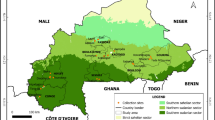Abstract
In this paper we present original data on morphological and genetic diversity of cassava managed by the Makushi Amerindians from Guyana. Although they propagate cassava exclusively vegetatively by means of stem cuttings, many Amerindian farmers also use and multiply volunteer plants grown from seeds produced by sexual reproduction. Morphological characters were recorded for 29 varieties cultivated by the Makushi and two populations of plants originating from volunteer cassava seedlings. Genetic characterisation with AFLP markers was available for 21 of the examined varieties. The morphological and agronomic characters were highly variable among varieties. Every variety could be differentiated from any other one, except for one pair of varieties. However, high intra-varietal variability existed, which might lead to confusions between phenotypically similar varieties by the Makushi. Seedlings were on average different from the pool of the varieties studied, but 67% were found to resemble closely enough one of the varieties to be liable to be assigned to it. Confusion between very similar varieties, as well as assignment of seedlings to a variety, should generate genetic variability within varieties, which was detected with AFLP markers. As in other sites in Amazonia, there was only a weak correlation between inter-varietal distances assessed with molecular and with morphological markers, suggesting that diversification of morphological characters has taken place repeatedly and independently across the Amazonian range of the crop. Diversifying selection, exchanges of varieties between farmers, and incorporation of sexually produced volunteer plants are key mechanisms responsible for the high diversity observed. Strategies of conservation of genetic resources should take these dynamic processes into account.
Similar content being viewed by others
References
Belkhir, K. et al., 2000. GENETIX 4.0, logiciel sous Windows TM pour la génétique despopulations. Laboratoire Génome, Populations, Interactions, CNRS UPR 9060, Université de Montpellier II, Montpellier (France).
Boster, J.S., 1985. Selection for perceptual distinctiveness: evidence from Aguaruna cultivarsof Manihot esculenta. Econ Bot 39: 310–25.
Brouat, C., M. Gibernau, L. Amsellem & D. McKey, 1998.Corner's rules revisited: ontogenetic and interspecific patterns in leaf-stem allometry. New Phytol 139: 459–470.
Brush, S.B., 1991. A farmer based approach to conserving crop germplasm. Econ Bot 45: 153–165.
Brush, S.B., 1995. In situ conservation of landraces in centers of crop diversity. Crop Sci 35: 346-354.
Carvalho, L.J.C.B., B.A. Schall & W.M.G. Fukuda, 1998. Cassava (Manihot esculenta Crantz) phenetic relationships and genetic diversity revealed by morphological descriptors and RAPD markers. Rev Brasil Genét 17: 13.
Chakraborty, R. & L. Jin, 1993. A unified approach to study hypervariable polymorphisms: statistical considerationsof determining relatedness and population distances. In: S.D.J. Pena, R. Chakraborty, J.T. Epplen & A.J. Jeffreys (Eds.), DNA Fingerprinting: State of the Science, pp. 153–175. Basel.
Chiwona-Karltun, L., J. Mkumbira, J. Saka, M. Bovin, N.M. Mahungu & H. Rosling, 1998. The importance of being bitter - a quantitative study on cassava cultivar preference in Malawi. Ecol Food Nutr 10: 1–27.
Dagnélie, P., 1975. Analyses Statistiques à PlusieursVariables. Les Presses Agronomiques de Gembloux, Belgique.
Dufour, D.L., 1995. A closer look at the nutritionalimplications of bitter cassava use. In L.E. Sponsel (Ed.), Indigenous Peoples and the Future of Amazonia: An Ecological Anthropology of an Endangered World, pp. 147–165. The University of Arizona Press, Tucson & London.
Elias, M. & D. McKey, 2000. The unmanaged reproductive ecology of domesticated plants in traditional agroecosystems: an example involving cassava and a call for data. Acta Oecol 21: 223–230.
Elias, M., O. Panaud & T. Robert, 2000.Assessment of genetic variability in a traditional cassava (Manihot esculenta Crantz) farming system using AFLP markers. Heredity 85: 219–230.
Elias, M., L. Rival & D. McKey, 2001. Perception and management of cassava(Manihot esculenta Crantz) diversity among Makushi Amerindians of Guyana (South America). J Ethnobiol (in press).
Felsenstein, J., 1993. PHYLIP. Phylogeny Inference Package. version 3.5c. Department of Genetics, University ofWashington, Seattle.
Hallé, F., R.A.A. Oldeman & P.B. Tomlinson, 1978. Tropical Trees and Forests. AnArchitectural Analysis, Berlin, Germany; Heidelberg, Germany and New York, USA. Springer-Verlag.
Heywood, V.H.,1995. Global Biodiversity Assessment. Cambridge University Press, Cambridge.
Langella, O., 2000.Populations 1.0.6, http: //www.cnrs-gif.fr/pge.
Mantel, N., 1967. The detection of disease clustering andgeneralised regression approach. Cancer Res 27: 209–220.
McKey, D. & S. Beckerman, 1993.Chemical ecology, plant evolution and traditional cassava cultivation systems. In: C.M. Hladik, A. Hladik, H. Pagezy, O.F. Linares, G.J.A. Koppert & A. Froment (Eds.), Tropical Forests, People and Food, pp. 83–112. UNESCO, Paris.
McKey, D., L. Emperaire, M. Elias, F. Pinton, T. Robert, S. Desmoulière & L. Rival, 2001.Gestions locales et dynamiques régionales de la diversité variétale du manioc en Amazonie. Génét Sél Evol (in press).
Nei, M. & W. Li, 1979. Mathematical model for studying genetic variations in terms of restriction endonucleases.Proc Natl Acad Sci USA 76: 5269–5273.
Rogers, D.J. & S.G. Appan, 1973. Manihot and Manihotoides(Euphorbiaceae). Flora Neotropica 13: 1–272.
Salick, J., 1995. Toward an integration of evolutionaryecology and economic botany: personal perspectives on plant/people interactions. Ann Miss Bot Garden 82: 25–33.
Sambatti, J.B.M., P.S. Martins & A. Ando, 2001. Folk taxonomy and evolutionary dynamics of cassava: a case studyin Ubatuba - Brazil. Econ Bot (in press).
SAS, 1996. SAS/STAT User's Guide, Release 6.12. Cary, N.C.: SASInstitute.
Second, G., A.C. Allem, R.A. Mendes, L.J.C.B. Carvalho, L. Emperaire, C. Ingram & C. Colombo,1997. Molecular marker (AFLP)-based Manihot and cassava numerical taxonomy and genetic structure analysis in progress: implications for their dynamic conservation and genetic mapping. Afr J Root Tuber Crops 2: 140–147.
Sokal, R.R. & F.J. Rohlf, 1985. Biometry. New York: W.H. Freeman.
STATISTICA, 1997. Statistica 5.1,StatSoft Inc, http: //www.statsoft.com.
XLSTAT, 1999. Xlstat 4.3, http: //www.xlstat.com.
Author information
Authors and Affiliations
Rights and permissions
About this article
Cite this article
Elias, M., McKey, D., Panaud, O. et al. Traditional management of cassava morphological and genetic diversity by the Makushi Amerindians (Guyana, South America): Perspectives for on-farm conservation of crop genetic resources. Euphytica 120, 143–157 (2001). https://doi.org/10.1023/A:1017501017031
Issue Date:
DOI: https://doi.org/10.1023/A:1017501017031




